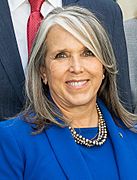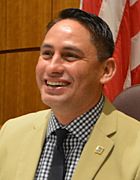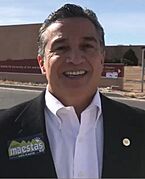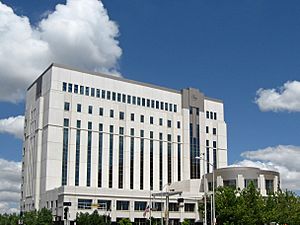Government of New Mexico facts for kids

|
|
| Polity type | Presidential republic Federated state |
|---|---|
| Constitution | Constitution of New Mexico |
| Legislative branch | |
| Name | Legislature |
| Type | Bicameral |
| Meeting place | New Mexico State Capitol |
| Upper house | |
| Name | Senate |
| Presiding officer | Howie Morales, President |
| Lower house | |
| Name | House of Representatives |
| Presiding officer | Javier Martínez, Speaker |
| Executive branch | |
| Head of State and Government | |
| Title | Governor |
| Currently | Michelle Lujan Grisham |
| Appointer | Election |
| Cabinet | |
| Name | Cabinet |
| Leader | Governor |
| Deputy leader | Lieutenant Governor |
| Headquarters | New Mexico State Capitol |
| Judicial branch | |
| Name | Judiciary of New Mexico |
| Courts | Courts of New Mexico |
| Supreme Court | |
| Chief judge | David K. Thomson |
| Seat | New Mexico Supreme Court Building, Santa Fe |
The government of New Mexico is the system that helps run the state. It is based on the Constitution of New Mexico. This system has three main parts, like three big teams working together.
These teams are:
- The executive branch, led by the Governor.
- The legislative branch, which makes laws.
- The judicial branch, which makes sure laws are fair.
New Mexico also has local governments. These help manage counties and cities.
Contents
Executive Branch: Leading the State
The executive branch is like the management team for New Mexico. It carries out the laws. The Governor is the main leader of this branch.
Here are some of the important elected officials in New Mexico:
- New Mexico's Elected Officials
The Governor's Cabinet
The New Mexico Governor's Cabinet is a group of leaders. They help the Governor manage different parts of the state. Each person in the cabinet leads a special department.
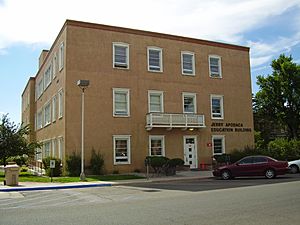
These departments help with many things. They cover areas like education, health, and transportation. Here are some of the departments:
- Office of African American Affairs
- Department of Aging and Long-Term Services
- Department of Agriculture
- Department of Children, Youth, and Families
- Department of Corrections
- Department of Cultural Affairs
- Department of Economic Development
- Department of Energy, Minerals, and Natural Resources
- Office of the State Engineer
- Department of Environment
- Department of Finance and Administration
- Department of General Services
- Department of Health
- Department of Higher Education
- Department of Homeland Security and Emergency Management
- Department of Human Services
- Department of Indian Affairs
- Department of Information Technology
- Office of State Personnel
- Department of Public Education
- Department of Public Safety
- Department of Regulation and Licensing
- Department of Taxation and Revenue
- Department of Tourism
- Department of Transportation
- Department of Veteran Services
- Department of Worker's Compensation
- Department of Workforce Solutions
Legislative Branch: Making Laws
The New Mexico Legislature is the part of government that makes laws. It has two separate groups, which is called a bicameral system.
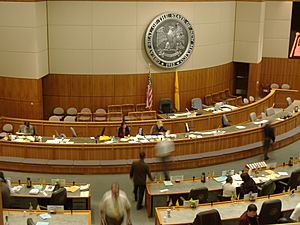
These two groups are:
- The New Mexico House of Representatives: This group has 70 members.
- The New Mexico Senate: This group has 42 members.
The legislature meets for a certain number of days each year. They meet for 60 days one year, and 30 days the next. The Lieutenant Governor leads the Senate. The House of Representatives chooses its own leader, called the Speaker. Both leaders help decide which laws are discussed.
Judicial Branch: Interpreting Laws
The judicial branch is made up of courts. These courts make sure that laws are fair and applied correctly. They also settle disagreements.
New Mexico Supreme Court
The New Mexico Supreme Court is the highest court in the state. It mostly hears appeals from lower courts. This means they review decisions made by other courts.
The Supreme Court has five justices. They are chosen by people voting in statewide elections. If a justice leaves early, the Governor can appoint someone new.
New Mexico Court of Appeals
The New Mexico Court of Appeals is the next level of court. It reviews decisions from district courts and some state agencies. Ten judges work here, usually in groups of three.
District Courts
The New Mexico district courts are general courts. They handle many different types of cases. These include cases about contracts, property, and family matters. They also handle serious criminal cases and cases involving young people. There are 13 judicial districts across the state.
Magistrate Courts
The New Mexico magistrate courts handle less serious cases. These include small money disputes, traffic tickets, and less serious crimes. There are 54 magistrate courts.
Probate Courts
The New Mexico probate courts deal with wills and estates. They do not have jury trials. Each of New Mexico's 33 counties has one probate court.
Municipal Courts
The New Mexico municipal courts handle minor offenses. These include small crimes and violations of city rules. They also do not have jury trials.
Bernalillo County Metropolitan Court
The Bernalillo County Metropolitan Court is a special court for Bernalillo County. It handles many types of cases. These include small money disputes, landlord-tenant issues, and traffic violations.
Local Government: Serving Communities
Local government helps manage communities. This includes counties and municipalities. Municipalities are also known as villages, towns, or cities.
New Mexico has 33 counties. Bernalillo County, where the largest city Albuquerque is located, has the most people. Counties are usually run by an elected commission of five members. They also have a sheriff, assessor, clerk, and treasurer.
Cities, towns, and villages can choose how they are governed. Their elections are non-partisan, meaning candidates do not run as members of political parties. Special districts and groups of landowners can also have some local authority.


